Related Research Articles

The .44 Remington Magnum, also known as .44 Magnum or 10.9x33mmR, is a rimmed, large-bore cartridge originally designed for revolvers and quickly adopted for carbines and rifles. Despite the ".44" designation, guns chambered for the .44 Magnum round, its parent case, the .44 Special, and the .44 Special's parent case, the .44 Russian all use 0.429 in (10.9 mm) diameter bullets. The .44 Magnum is based on the .44 Special case but lengthened and loaded to higher pressures for greater velocity and energy.
The .256 Winchester Magnum is a firearms cartridge developed by Winchester, and was produced by necking-down a .357 Magnum cartridge to .257 diameter. It was designed for shooting small game and varmints.

The .38-40 Winchester (10.17x33mmR) is actually a .40 caliber (10 mm) intermediate cartridge shooting .401 in (10.2 mm) caliber bullets. The cartridge was introduced by Winchester in 1874 and is derived from their .44-40 Winchester. This cartridge was introduced for rifles, but in its reintroduction for cowboy action shooting it has seen some popularity as a revolver cartridge. It is not particularly well suited to hunting larger game, but it was popular when it was introduced, along with the previous .44-40 Winchester, for deer hunting. It can be used successfully on smaller game animals, and for self-defense. Current loadings are intended for revolvers.

The .22 Hornet or 5.6×36mmR Hornet is a varminting, small-game hunting, survival and competition centerfire rifle cartridge commercially introduced in 1930. It is considerably more powerful than the rimfire .22 WMR and the .17 HMR, achieving higher velocity with a bullet twice the weight of the .17 HMR bullet. The Hornet also differs significantly from these in that being a centerfire cartridge makes it reloadable, and thus more versatile. It was the smallest commercially available .22 caliber centerfire cartridge until the introduction of the FN 5.7×28mm.

A wildcat cartridge, often shortened to wildcat, is a custom-made cartridge for which ammunition and/or firearms are not mass-produced. These cartridges are often created as experimental variants to optimize a certain ballistic performance characteristic of an existing commercial cartridge, or may merely be intended as novelty items.
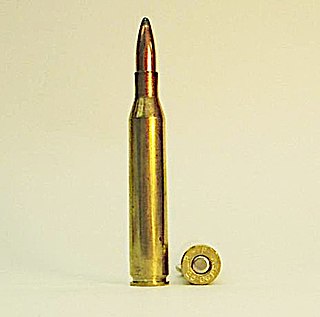
The .25-06 Remington was a wildcat cartridge for nearly half a century before being standardized by Remington in 1969.

.17 Hornady Magnum Rimfire, commonly known as the .17 HMR, is a rimfire rifle cartridge developed by Hornady in 2002. It was developed by necking down a .22 Winchester Magnum Rimfire case to take a .17 caliber (4.5mm) projectile. Commonly loaded with a 17 grain projectile, it can deliver muzzle velocities in excess of 775 m/s.
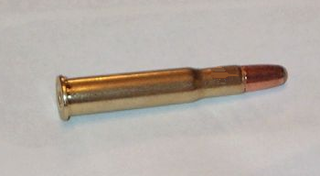
The .30-30 Winchester / 7.8x51mmR cartridge was first marketed for the Winchester Model 1894 lever-action rifle in 1895. The .30-30, as it is most commonly known, along with the .25-35 Winchester, was offered that year as the United States' first small-bore sporting rifle cartridges designed for smokeless powder. Since its introduction, it has been utilized alongside the development of flatter shooting cartridges, most prominently those derived from designs subsidized by interest in military expenditures. The .30-30 has remained in widespread use almost entirely because of reliable effectiveness in civilian applications, and has put food on the table for millions of people in hunting situations.
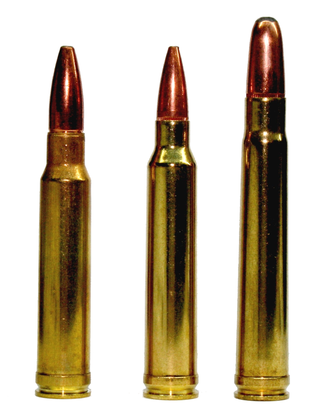
The .300 Winchester Magnum is a belted, bottlenecked magnum rifle cartridge that was introduced by the Winchester Repeating Arms Company in 1963. The .300 Winchester Magnum is a magnum cartridge designed to fit in a standard rifle action. It is based on the .375 H&H Magnum, which has been blown out, shortened, and necked down to accept a .30 caliber (7.62 mm) bullet.

The .416 Remington Magnum is a .416 caliber (10.57 mm) cartridge of belted bottlenecked design. The cartridge was intended as a dangerous game hunting cartridge and released to the public in 1989. The cartridge uses the case of the 8 mm Remington Magnum as a parent cartridge. When the cartridge was released in 1988, author Frank C. Barnes considered the .416 Remington Magnum to be the "most outstanding factory cartridge introduced in decades".

The .284 Winchester (7.21x55mmRB) is a rebated rim firearm cartridge, introduced by Winchester in 1963.
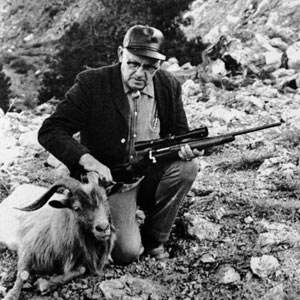
Parker Otto Ackley was an American gunsmith, barrel maker, author, columnist, and wildcat cartridge developer. The Ackley Improved family of wildcat cartridges are designed to be easily made by rechambering existing firearms, and fireforming the ammunition to decrease body taper and increase shoulder angle, resulting in a higher case capacity. Ackley improved not only standard cartridges, but also other popular wildcats, and was the first to create a .17 caliber (4.5 mm) centerfire cartridge.
The .256 Newton was a high-velocity, rimless centerfire cartridge based on the .30-06 Springfield military cartridge and developed in 1913 by Charles Newton in conjunction with the Western Cartridge Company. To make the .256 Newton cartridge, the .30-06 case was necked down to a caliber of .264 inches, the overall case length was shortened, body taper was increased, the neck was moved back, and the shoulder was given a sharper, 23-degree angle, as opposed to the 17-degree shoulder of the parent cartridge.
The .45 Super / 11.5x22mm is a powerful smokeless powder center fire metallic firearm cartridge developed in 1988 by Dean Grennell, a well-known writer in the firearms field as well as managing editor of Gun World magazine. It is dimensionally similar to the .45 ACP round but has a thicker case wall and is loaded to higher pressures, which offers an average 300 feet per second (91 m/s) improvement in muzzle velocity over the .45 ACP. The cartridge was co-developed by Tom Fergerson and Ace Hindman.
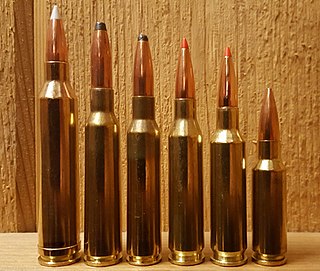
The 6.5mm Creedmoor (6.5×48mm), designated 6.5 Creedmoor by SAAMI, 6,5 Creedmoor by the C.I.P. is a centerfire rifle cartridge introduced by Hornady in 2007. It was developed by Hornady senior ballistics scientist Dave Emary in partnership with Dennis DeMille, the vice-president of product development at Creedmoor Sports, hence the name. The cartridge is a necked-down modification of the .30 Thompson Center.
The .20 Tactical is a wildcat centerfire rifle cartridge, based on the .223 Remington case, necked down to fire a 5.2 millimetres (0.204 in) caliber bullet. The .20 Tactical was designed by Todd Kindler and predates the .204 Ruger factory round. The case has approximately 0.2 grams (3 gr) less powder capacity than the popular .204 Ruger. Handloaders can get velocities with 2.1 and 2.6 grams projectiles that almost match the .204 Ruger. Furthermore, the .20 Tactical is also able to achieve these velocities with less powder than the .204 Ruger by more efficiently using high energy propellants such as Alliant Reloader 7 and Winchester 748. Based on the .223 Remington, a wide selection of brass is available, and can also be formed from .223 casings by use of a forming die.
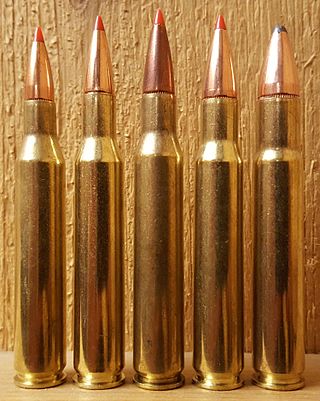
.30-06 Springfield wildcat cartridges are cartridges developed from a 30-06 Springfield "parent cartridge" through narrowing or widening the cartridge neck to fit a smaller or larger bullet in an attempt to improve performance in specific areas. Such wildcat cartridges are not standardized with recognized small arms standardization bodies like the SAAMI and the CIP.
Charles Newton (1868–1932) was an American lawyer and firearm enthusiast known for his experiments with cartridge design which led to the creation of the .22 Savage Hi-Power rifle cartridge which was adopted by the Savage Arms as a commercial firearm cartridge. This success was soon followed by the design of the .250-3000 Savage.

A varmint rifle is a small-caliber precision firearm or high-powered airgun primarily used for both varmint hunting and pest control. These tasks include killing three types of pests or nuisance animals that spread diseases or destroy crops or livestock:
References
- 1 2 https://ammo.com/articles/charles-newton-wildcatter-created-22-savage-250-savage-forgotten-history
- ↑ https://www.rifleshootermag.com/editorial/ranking-the-30-magnums/316613
- ↑ https://www.shootingtimes.com/editorial/developing-30-newton-prc-wildcat/388616#replay
- ↑ http://www.thegunmag.com/jamison-brass-back-in-business-making-brass-and-loaded-ammo/